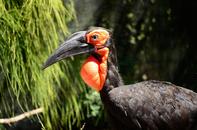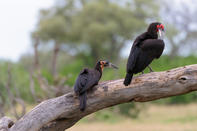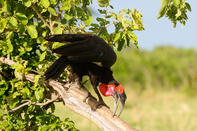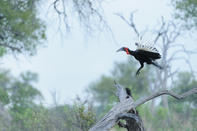Mate for Life
Ground hornbills are conspicuous by their size and their striking black plumage and red wattles. More so they habitually occur together in groups of four to five birds (but up to 8 or 9) and spend much time in the open scouting for their prey which comprises lizards, insects, small mammals, snails, birds and venomous snakes.

They are specialists at feeding on tortoises that they are able to break open with their strong bills.
Ground hornbills are long lived birds and only reach maturity at six years old at which time female birds will leave their natal flocks and join up with a group of males to form new flocks. The dominant pair within the flock mate for life and the co-operative group defend a territory of about 100 km² advertised with a booming ‘hoo hoo hoo-hoo’ duet that carries over 4 km in distance. They will also chase offending neighbours in flight.
A dominant female can be recognised by the patch of blue amidst her red throat patch. Juveniles have drably coloured faces that turn red at about 3 years old.
Nesting in Big Trees

Ground hornbills’ nesting sites are hard to come by. They require large tree cavities at least 40 cm wide and located 4 to 7 meters above the ground. These are found only in the largest of trees such as jackal berries and baobabs and are becoming scarcer due to logging, local wood collecting and elephant damage. They do not close up the entrance to their nests in the manner of the yellow-billed or red-billed hornbill.
The female will enter the cavity when she is ready to breed and the male and the helpers bring nesting material and food to the female. They continue this ritual throughout incubation as once the first egg is laid the dominant female will not leave the nest except to defecate.
One or two eggs are laid but the second chick normally doesn’t survive as the first chick is much further advanced by the time the second hatches and the second is quickly out-competed. The second egg is produced as an insurance policy should the first not survive.
Supplementary Fed

Chicks are altricial (blind, helpless and nest bound) and the breeding process is particularly protracted. The incubation of the eggs takes 40 days and the nestling period continues for sometimes over 85 days. The chicks only start to feed themselves at 6 to 12 months old but are supplementary fed by the members of the flock for two years at which point their development is far enough advanced for them to become helpers themselves.
Quite Endangered

Breeding is irregular in ground hornbills and thought to be linked to rainfall. Generally flocks produce a chick once every six years and for this reason, the species is quite endangered as viable populations can only be sustained if birds survive for a minimum of 28 years.
Traditionally the ground hornbill is considered a sacred ‘wise spirit’. Damage to a hornbill can only be atoned through the sacrifice of a calf and the bird is not spoken of for fear of retribution. Their distinctive call is supposed to indicate rain and in some countries, their skulls and bills feature in hunters' headdresses.
By Megan Emmet